Here’s a situation many of us have encountered: shopping with someone and being persuaded to buy something we did not need. While at an antiques show, a friend and I spotted an old Chinese carved granite trough (originally for holding farm animals’ drinking water). My friend looked at me, and out came “so cool, Loi!” “You’ve GOT to buy that!!” Really, but I don’t have any horses or pigs??!! After a brief chat, I ended up hauling this massive and heavy-as-heck trough home.
For a while, the trough sat upside down in a hidden corner of the garden 🙁 I thought of converting it into a powder room sink. But, it was just too heavy – both physically and visually.
One morning in the midst of watering all my individual pots of herbs, the idea of using the trough as an herb planter came to me. Yes!!! I now plant it with various herbs, and experiment with different combinations each season. Having most of the herbs in one pot is handy, and easier to water. I also have separate pots for rosemary and mint. The rosemary prefers it drier, while the mint is very aggresive.
Placed on the sunny terrace outside our kitchen, the herb trough comes in handy.
Even though our trough already had a hole in the bottom, I placed a layer of gravel to improve drainage.
Together with this prolific fig shrub and pots of rosemary and mint (both not shown), this is our mini urban kitchen garden.
While we were on vacation, many of the herbs flowered. After these photos, I quickly removed all the flowers. Herbs allowed to flower and seed can die back or develop bitter leaves.
In addition, soapstone sinks, marble wash basins, oversize mortars, and galvanized tubs would make wonderful herb planters. Just make sure to cut / drill a drainage hole. An architectural salvage yard is a great source for such pieces. Also, search online with the following keywords:
– Chinese granite trough
– Stone trough
– Old soapstone sink
– Turkish marble basin
Happy planting!
Loi


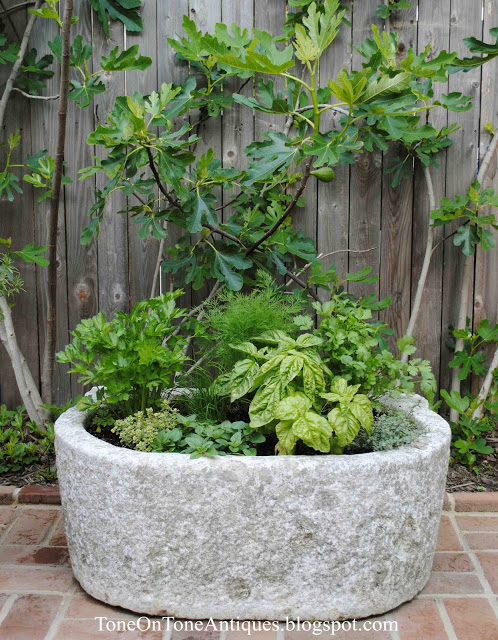
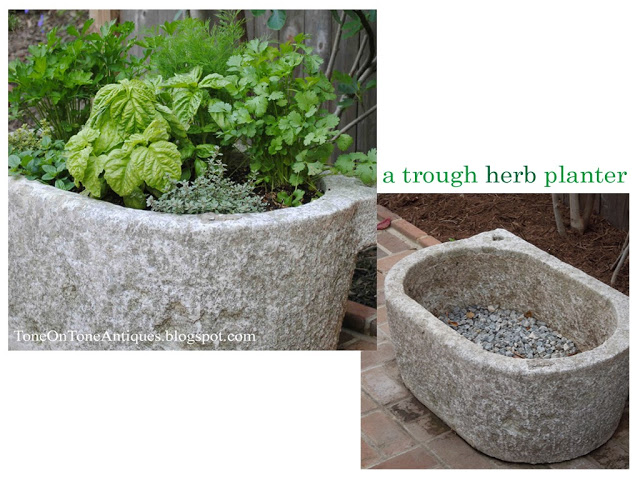
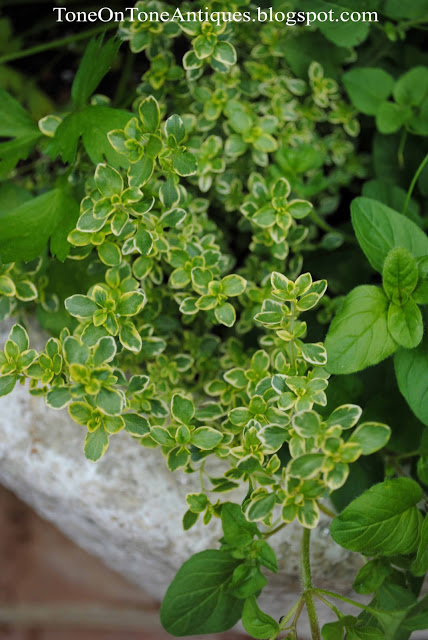
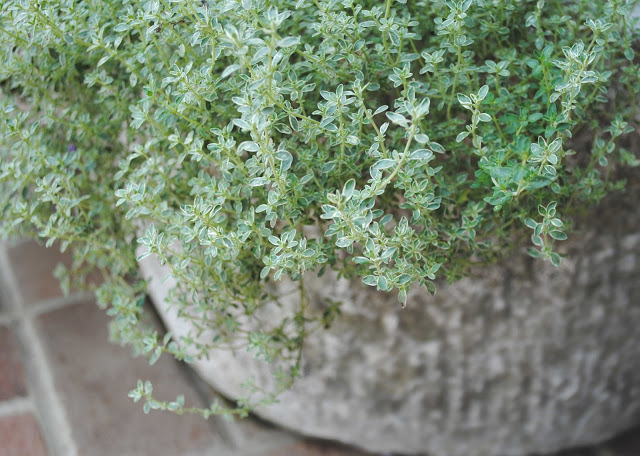
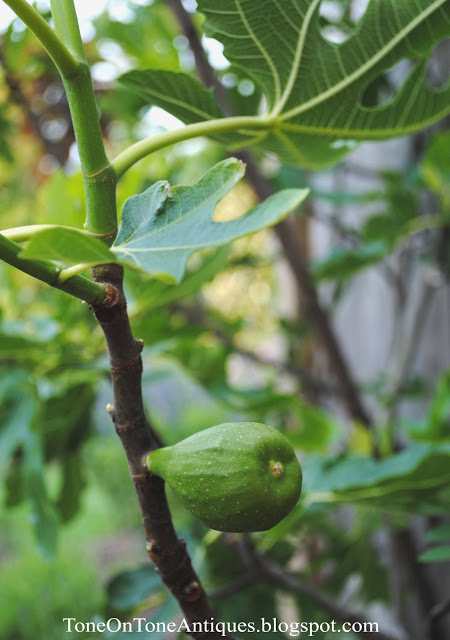
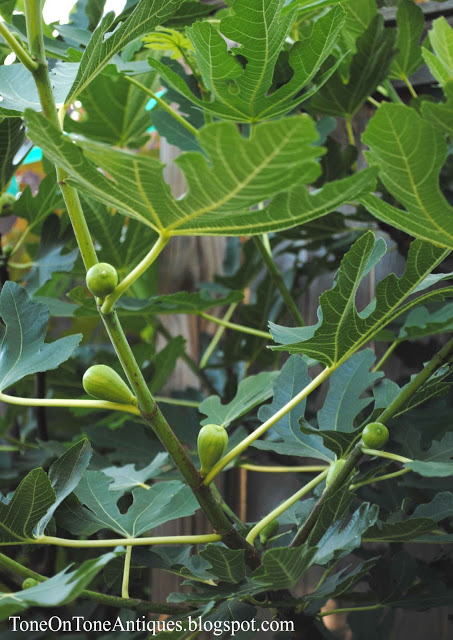
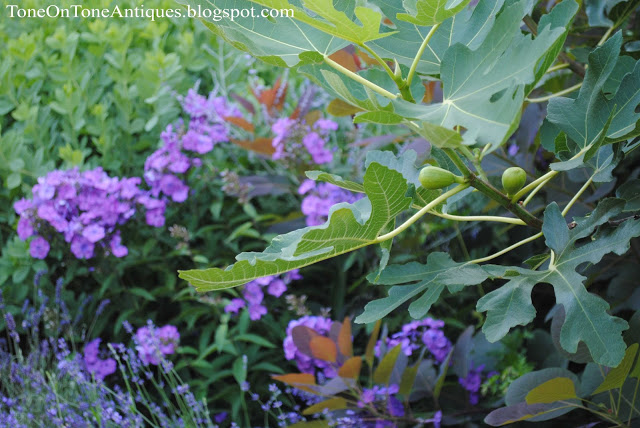
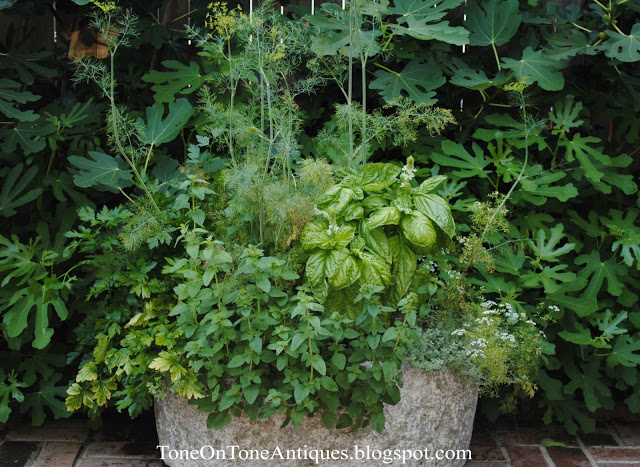
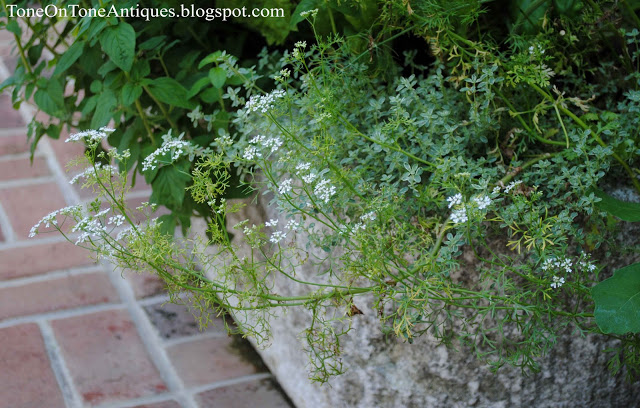
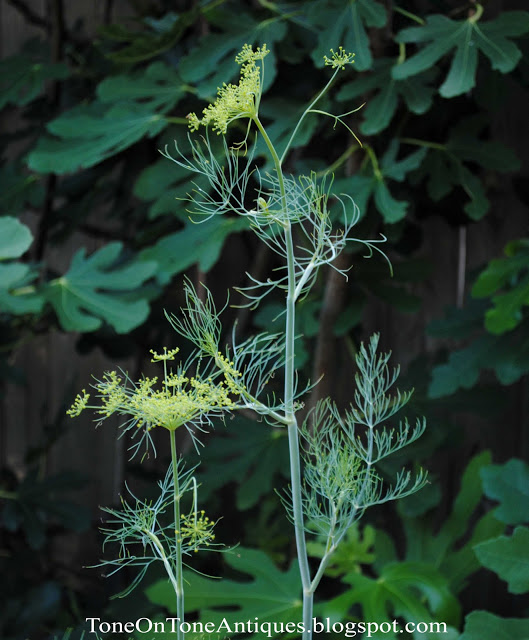
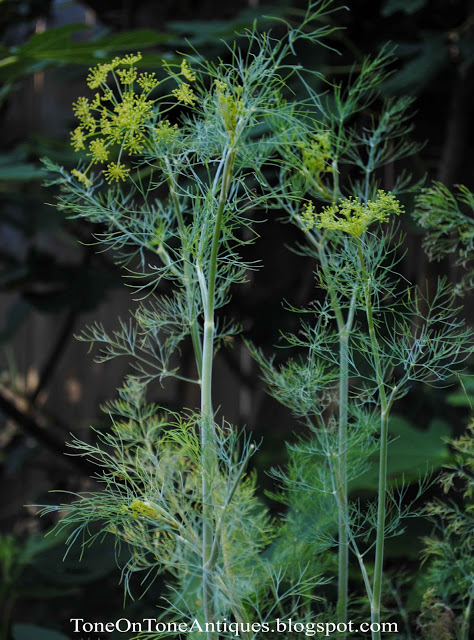
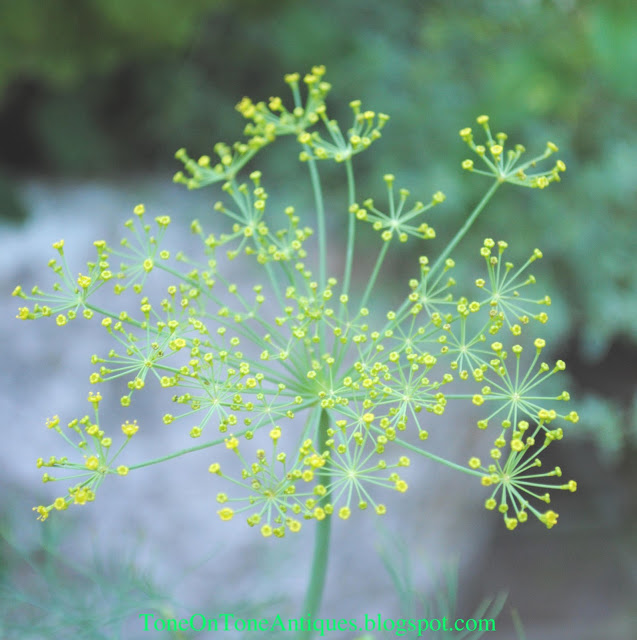
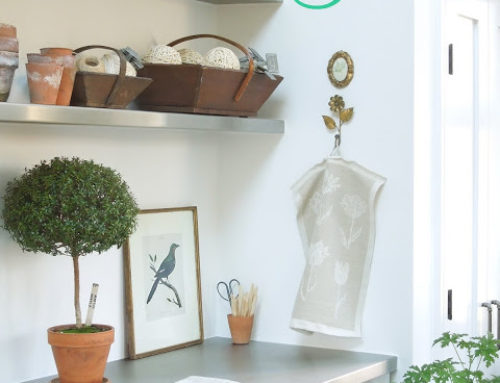
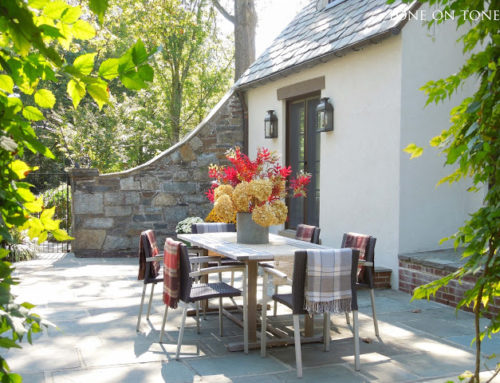
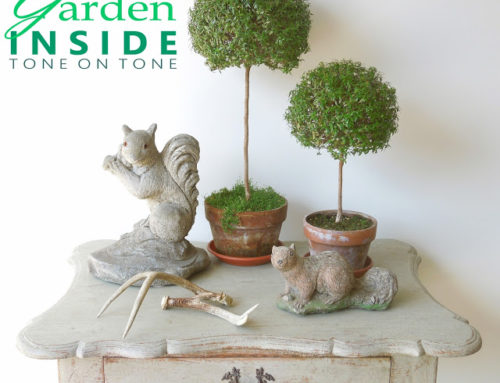
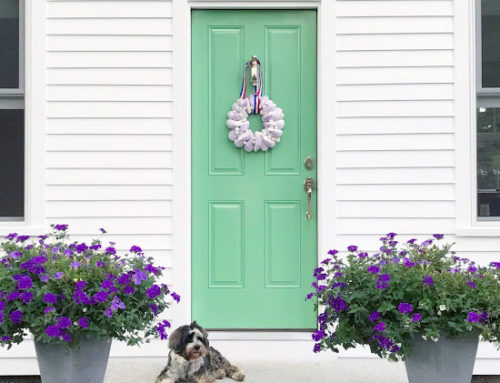
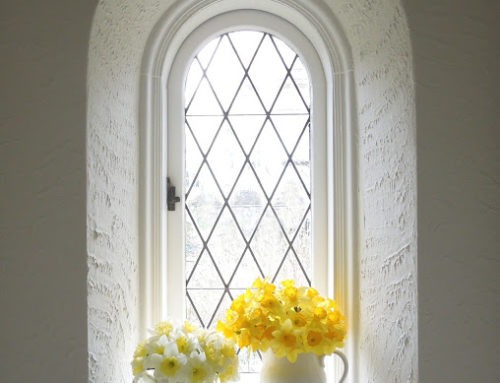
Your creativity amazes me Loi! This is a perfect herb planter! Your friend wa sright…you did need this!
The very first photo of the dill is perfect – worthy of a frame.
So often I buy things, get them home, and wonder whatever shall I do with it? However, often in time the answer emerges, as with your lovely granite tough. Really nice trough, and you have found the perfect solution.
Whoa, that opening photo is sooooo gorgeous. I love this trough. It looks best with herbs, since horses would muck it up! Can't wait to lunch with you soon.
Hope you have a wonderful weekend and enjoy cooking with your fresh herbs.
xo Nancy
YOu did very well my friend in buying this piece. I could see how you would want to use this as a fabulous sink in a powder room, but yes, I suspect it is very heavy. BUt this is the perfect herb container, and it is GRAY AND GRANITE and hearty! Doesn't the gray-green of the thyme just look wonderful against the stone? You did well! And I was so excited to see this post. My herbs are taking over and I just had to cut back on my oregano; the flowers started to sprout!
I think I'll make a marinara sauce tonight with my basil and oregano, and even some thyme. You will not want to hear this but our temps are only going to reach 60 today! Be well my dear, Anita
You can always move it around frequently by way of a bicep workout too. Your friend was very thoughtful, you see!
A good workout for me and 2 helpers!!! Mostly for them 🙂
Glad you came up with a great way to use that. I need to plant some herbs. I did last year and never got to it this year. Wish I lived in a climate where we could grow them year round.
The trough is a fantastic find! I would have stayed awake nights thinking of where and how to use it!! You found the perfect solution!
It "looks" like a great sink for a powder room, but I can appreciate the reasons why it didn't work!!!!
I love this trough Loi……a beautiful piece, and perfect for your herbs! Thank you so much for your comment yesterday, and I am glad you enjoyed my showcase of my friend Clare's stunning garden. Ahh…..so you know the Architectural salvage store in Tunbridge Wells?…….I love this shop, and there's always something striking and interesting to be found there!
Have a lovely weekend!
Sophia x
Dear Loi you always fascinate me with your unusual uses for items you have found in your journey's!!
As an herb garden the trough is perfection. Now it is handy to just step out and get what you need to add to your dinner dishes!
xoxo
Karena
2013 Designer Series
Fabulously done! You are so creative…..such a wonderful and stylish way to grow an herb garden!
Wow Loi, that would be like shopping with me. You created something useful from the trough. Your herb planter is so beautiful and very useful now for your meals. We have mint too and we make our own mint tea from it. Have a wonderful weekend!
I love the idea of shopping with a friend to have a scapegoat when needed. But this story turned out to have a happy ending. There's nothing better than getting both utility and beauty. You've also reminded me that I should get some dill. I love it in cucumbers, yogurt and summer potato salads and it would be great to have it fresh on hand.
I also know where there such a basin locally. I was considering using one for a bathroom sink but I thought it was much too heavy so such a small space. And there it sits more than a year later waiting to become someone's herb garden.
Beautiful Loi!!! Love the idea!
xx
Greet
Your trough looks so lucious, overflowing with herbs. We have mint, basil and rosemary that we grow and use daily in our cooking. I'd love to have a more extensive herb planter such as yours 🙂
Loi, As with everything you do, this is perfection. Love how the herbs spill over the rough texture of the trough and its gray texture looks great surrounding by all the different greens. Always a pleasure to visit here,
Happy Saturday,
Kathysue
That is a fantastic idea–and gorgeous. I spied the basil.
Have a super week-end. xoxoxo
Mary
Great idea, Loi! Beautiful and all in one place.
My mouth waters every time I see a fig!
Teresa
xoxo
I like the trough but I'm really distracted with your fig espalier! Now that's an idea for my small space… all I have to do is figure out where to get a fig cutting. Your garden is fabulous.
Thanks so much! I see you are in MD. If you are ever in Bethesda, drop by and say hi 🙂
I soooo love your blog Loi!! Surprisingly I am either in step with you or two to three behind in deep thought and then you provide me with the finishing touch idea or an answer to my dilema. I was looking at a old galvanized wash tub that I have had for about 20 plus years wondering what to do with it…I also need to replant the basil and parsley from a small window box…the rosemary was in with these two herbs as well and according to your info needs a different solution…after reading your blog I have the solution to moving the tub out of the garage (more space) and a place for the herbs…thank you. Your pics are always great and info and insight much appreciated. Inspiring blog! I did make a hypertufa sink some time ago that resembles the rough stone finish( couldn't move it so be sure to make it on the spot you will want it to sit in. Check out Alan Titchmarsh's instructions on the web. Just love the fig…not sure we have the right temps in Ontario.
Thanks, Maggie! Enjoy planting your herb galvanized tub, and let me know how it turns out. Cheers!
Loi, I didn't know that it's not good to allow the herbs to flower.. interesting! Thyme.. it does smell incredible and I also like rosemary and basil. When I bring them in freshly cut or from the farmers market I often place them on the counter in water to enjoy like a flower arrangement. This trough is so unique and I love what you've done with it. I could have also seen it in the bathroom as a sink! Nicely done Loi and enjoy your weekend! xxleslie
it's just perfect for your herbs! i have mine in a low window box outside of my screen porch just steps from the kitchen. i use them for cooking, yes, but their main purpose is scent. i walk past them, touch them and inhale them. yum!
thanks for this inspiration i am filing away!
michele
p.s.
thanks so much for the referral to your clients! a larger custom seascape just made it to bethesda, and i'm so grateful. 🙂
Great idea Loi, Your photos are amazingly perfect , I can't believe you aren't a professional !
Lovely Loi! We have a small planter box that always serves as my herb bed. I adore thyme and grow way more than needed as I love the way it smells. We grow a LOT of basil and also mint and spearmint. Yes, they are a bit invasive. I did not know that about flowering. I always let them go to flower and enjoy watching the bees make oregano honey. haha. I wish I could find their honeycomb…
Love the trough in this application. Oh and rosemary….heaven but we rarely cook with it as I find it can be so heavy in flavor.
xo Terri
What a great use for a very cool piece! It reminds me of something I saw earlier this week about hypertufa planters. I love the look of it. As always, your green thumbs inspire awe in me as mine are rather brown.
-Revi
You have wonderful friends if they convince you to buy such lovely things! 😉 It's the things you think you don't need that end up being the best finds. The trough makes a perfect planter for your beautiful herbs!
xo Kat
What a great use for a very cool piece Loi!!! Yourr photos are amazingly perfect , I can't believe you aren't a professional !
I am only beginning to experiment with growing herbs. Love the ideas for possible containers.
That is so funny. I have one of those that I made myself buy!! After sitting at the side of my house I turned it into a fountain with an egg light in it. I am so over it and was going to turn it into a planter. Now I have a purpose! Thank you for being inspiring and wonderfully encouraging😀. Xoxo, K
this is fabulous! i love the contrast of the fresh greens with the trough…. very cool!!
Serendipity filled with aromatherapy! PERFECTION 🙂
Thanks, Caspar! It's been too long. Hope you are having a wonderful summer in Scotland.
Troughs are perfect for herbs and trailing plants- I had a very large old horse trough on my old property which was a former dairy farm. I loved playing with different herbs and also used soapwort and lobelia (tough to keep in bloom, though). Your trough is just delightful!
xo
Mimi
Hi Loi,
It's gorgeous! Isn't it so fitting that in time, you figured out the perfect use for this trough, both practically and aesthetically, filling it with fragrant herbs that are equally just as pretty?!
Thanks for sharing this gem of a find, in the end!
Poppy
Hello Loi, After getting past the words "old" and "stone", the rest seems irrelevant–it's a must-have. Your trough looks great planted with herbs, but it would also be intriguing empty as an antique/sculptural object. I don't think I've seen one of these in Taiwan, but since I keep an eye on eventual shipment home, I try to avoid large stone objects.
(Immediately after writing that last sentence, I can think of a few exceptions to that maxim (a jade boulder comes to mind), but then rules are made to be broken.
–Road to Parnassus
Indeed, rules are made to be broken! Hope you are having a relaxing summer, Jim. Look forward to you posting, again.
What stunning pictures and what a gorgeous. Planter that makes! Amazing inspiration as I still miss my old herb garden. What a great new idea — the galvenized tub! Sooo doing that next summer!
What a great post, Loi! I can see why your friend thought you should buy it – it is very cool and you have put it to a perfect use. Beautiful photos as always! xo, Phyllis
Loi,
What a fabulous find. I had to laugh at the first sentence…honestly, sometimes I'm so easily swayed when a friend states, in earnest, Oh, you really need this! So often I think, maybe they're right. 😀 In the case of the overly heavey trough, it appears they were right. What a great herb garden you have. I am tempted to plant a fig after seeing how pretty your fig looks as a backdrop to the herb garden. Great post.
Hope your weekend is relaxing and wonderful.
xo,
Karen
Oh I just love it Loi!! I remember years ago seeing a granite piece that Martha Stewart had at her home in Maine and she put plants in it and I just loved it. Herbs are the first thing I ever grew and they will always have a soft spot in my heart. So my heart starting beating fast when I saw that you put two of my loves together!!
Very attractive and so practical. Love the look…
Thanks, Marlene! Is your first visit? Hope to hear from you again!
simply perfect loi, perfect
cheers
debra
Lovely! I'm glad you bought it!!
Thanks, Patty! I had doubts for a while. Now I love it!!
That is a very superior trough!
Loi, I love this idea, the trough is perfect here with herbs in it….I too have been wooed by the idea of figs in my garden…really, here in Canada? I think I would love to see one in a beautiful planter on a sunny terrace here…I almost brought one home earlier this summer from the garden center! Your herbs are doing great…enjoy the rest of summer…it is going quickly! N.xo
Hi Loi,
That is absolutely stunning! I LOVE it. Your herbs look so healthy even with all the crazy rain this summer has brought us.
Susan xoxo
Hello Loi, Like you I have succumbed to friend's suggestions and purchased items I later regret. I love how you have used it as your herb container. I see you have figs, I am so thrilled for you. This is a fruit I have wanted to grow.
Have a delightful week
Helenxx
Hi, Loi. Thank you for your visit… 🙂
I love your photos and I visit your blog from time to time just to watch.. 🙂
Cheers from Bucharest,
Ana.
Well of course you had to take that thing home. I love how you used it. I can't imagine the support that it would need to be a sink. It's a lovely addition to an already perfect garden.
Loi,
What a great way to use the trough, I love how the herbs are delicate compared to the rugged texture of the trough. Also thanks for the advice with not allowing herbs to go to seed… I let mine go this year because I loved the texture of the flowers, but now I know better 🙂
Liz
Hi Loi,
What a great idea to use the troug as a herb planter! Your figs look good. We had a fig tree in our garden too, but unfortunately did not do very well. Have a good new week!
Madelief
Love it…I want one now. I love to grow herbs and really love interesting planters. I'm growing herbs this season in large round willow baskets. Have a great week.
Loi,
How perfect! I love how all the herbs get along in their new enviornment. Great color, display, height, textural interest and balance the greens add to the mix. Great way to turn a situation (trough purchase) into a great solution. Sometimes ideas need to be left alone before they sprout a passionate design solution.
Bette
Of course you "needed" that! I love it with herbs, but it would be awesome here on our farm. I'm betting the stone helps keep the water cooler for the animals.
Loi….what a great idea and it looks so good in your garden! I have a friend who took an old bath tub and made it into a planter…
What a fun and cool idea! Thanks for sharing!!!
Hi, Loi,
I might have encouraged you to buy that basin, too, because it does look perfect in your garden. Thanks for the inspiration!
I love it, Loi! What a clever use of this beautiful object. Your herbs look so much happier than mine do. Your garden is just lovely. A perfect spot to sip a glass of rosé on a summer evening with the scent of herbs in the air!
I love your garden in a trough! You found the perfect use for it. Isn't it amazing how quickly basil will flower? Very determined! Happy snipping and cooking, Suzanne
Herbs in troughs are a great idea, and yours look great near your fig tree. (Good also to contain the mint – my lemon balm has become invasive everywhere. I pull it out by the handfuls.) Don't you just love the fragrance of dill, especially in flower arrangements and it has the good manners to stay where you plant it. The trough was a stellar purchase!
By the by, have you ever been able to winter over rosemary? Mine always dries out and sadly perishes.
b
Billie – In the fall, I will put the rosemary with its pot in the ground. So far, no problems. But our winters are milder than yours.
What a brilliant idea and super fantabulous photos, the first with the lush green foliage against the fence with your gorgeous typography is stunning. You did a great job with the trough Loi, I recently read that Fennel inhibits the growth of surrounding plants but that doesn't occur in our garden or your trough or anywhere I've seen it grown! I really need you to have a word please Loi! Vive le fenouil!x
Thanks, Paul! I didn't know that about fennel. Very interesting! Will keep an eye on it.
Loi,
It's the perfect addition to your garden! I adore the texture and the almost juxtaposition of rough with soft when looking at the texture of the herbs in the pot. It certainly adds depth and a wonderful element of surprise. Beautiful my fiend. xx
*friend:-)*
Loi, your herb garden looks fabulous! As does your trough. What an interesting and beautiful piece. Tell me what wonderful meals are you cooking with all of your herbs?
Have a great week!
Elizabeth
Thanks, Elizabeth! We love basil with vine ripened tomatoes and mozzarella. So easy for summer!!
I love the look of your planter. What a creative way to use the trough. Your herb garden is beautiful. I bet everything smells amazing.
Nice! I just planted my old strawberry pot with herbs and placed it beside the grill with "snippers" close by. franki
Planting a strawberry pot with herbs is a great idea! Thanks for sharing, Franki!!
Dear Loi,
Your herb planter is so lovely– that trough has wonderful character and proportion. I'm laughing as I write this, because as I was reading your post and looking out the window at my own small herb planters, one of our young squirrel friends mowed the whole thing down…delicious! I guess I won't have to worry about trimming back to prevent bitter leaves ;)!!!
Warm regards,
Erika
I'm glad you gave in to buying it — what a find! I love your fig trees too.
Using it for an herb garden is the perfect solution – it looks so beautiful and functional too – the perfect combination!!
Aren't you glad now that you were persuaded to buy, it's marvellous. A lot of people here spend hundreds on buying old mill stones. Thir only purpose is decoration as they are propped up against things. At least your hunk of stone has a useful function. Perfect!
Much love.
Di
xxxxx
Acabei de conhecer o seu blog,achei maravilhoso.Visite-me:http://algodaotaodoce.blogspot.com.br/
Siga-me e pegue o meu selinho!!!
Obrigada.
Beijos Marie.
I have to admit, dear Loi…that is a really cool piece!!! 🙂 And your herbs are gorgeous!!
A creative solution from the most creative Loi! ;))
Have a splendid weekend, dear friend! Hope it's not too hot…
Hugs,
– Irina
Hi Loi!
I love your herb planter!
Your garden shots are always so inspiring!
The trough will still look without the dill and cilantro. It's unfortunate that the dill and cilantro will cut even if you do cut the foliage back – the hot warm temperatures usually send them into reproductive mood! Nice trough!
I love discovering an architectural or vintage piece and finding a new use for it, and your trough is a perfectly lovely example Aren't fresh herbs heavenly?! We have a 12' x 4' herb garden and I walk out each evening to gather fresh herbs for whatever I'm cooking up in the kitchen. I always plant lemon verbena too, just so I can smell it – so wonderful! I've never had much luck with dill or cilantro as it goes to seed so quickly, but everything else thrives. The best part, the more you cut the faster it grows back!
Loi, I got a very similar trough and unfortunately it cracked when I carelessly left water in it too long in autumn and the water froze unexpectedly. I have been toying with making it a planter. You may have persuaded me to give it a try. Yours is beautiful.
Loi, Love your stylish stone kitchen herb garden! Please tell me you are making fun herbaceous simple syrups for cocktails with those gorgeous herbs!
Monica
Gorgeous, Loi! I can't get enough lemon thyme these days. We are about to start landscaping our courtyard and I can't wait to have herbs again! Love the idea of using an antique trough. Thanks for the inspiration!!
Alexis
What a great idea Loi! Herbs look wonderful against anything gray don't they? I have mine planted in zinc troughs and pails…
Dear, dear Loi! It's always so good to see you come to visit me! What a friend you are indeed. I have to tell you this; I saw a fabulous Swedish sofa the other day with a gray velvet upholstery and it's just on the other side of town. I thought of you immediately, and MYSELF as I would love to get it!
You always inspire. Have a happy Sunday, you and Tom! Anita
I bet even you could make those peanut butter cups… 😉 I mostly taught myself to cook, but have to say, if someone wanted to take over (at least part of the time)…I would not object! hee… Actually, my DP is the better cook, but since he works full time, it's up to me.
Thanks so much for vising me, dearest Loi!!
Hugs,
– Irina
Loi,
I actually prefer to shop alone for that very reason!!! I just make better decisions about things…what I "must" have that no one else would understand versus things I don't need at all that end up in my closet. But, I must say…I love this trough you ended up with. The herbs look heavenly in it. And, I just learned that when the herbs flower…they are no longer good.
Thanks, as always, for inspiring and encouraging!!!
xoxo Elizabeth
I think you could take just about any container and plant a weed in it and we would be all "dang…that is the most beautiful thing ever!"